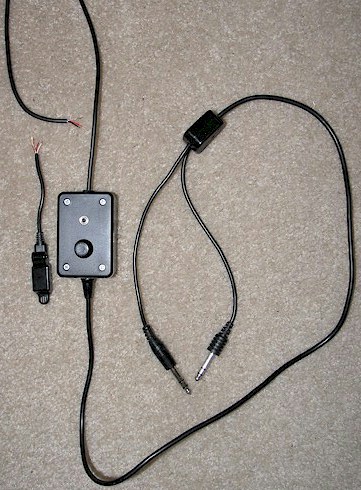I am curious on your thoughts of the NR10 when it comes in. Perhaps you could use it with an mp3 player at ATC voice volume while running up a plane to see it's attenuation for now until you build your set.
The earpieces can be wired directly to the headset cord. Up to you. I like the separate 1/8" jack so I can bring my headset home with me and use it for other things. There are two headset wires coming from the plug, one is the mono channel (on mine) and the other a ground. There was an extra clipped wire that may be the other channel for a stereo headset - sometimes cheaper to use the same cord for all your headsets sold and just not use some of the conductors on the cheaper mono sets like mine. The headset plug is stereo, so all I need to do is disconnect my left and right channel jumper on the 1/8" jack, and connect the clipped wirefrom the cord that is hanging in the breeze within the project box (after testing continuity with the plug to doublecheck).
The headsets will likely be louder at a given volume than a regular cupped headset, but the inline volume will make that moot. Without this, you will need to add transformers (one of mono) or potentiometers to better match the intercom output with your headset. Read the links (not Pete Howell's) I posted to see what I mean. No thanks, much more complicated.
The mic is what has the circuitry - it was a simple 1/2" wafer from my simple AvComms - I found it in one of the cups and carefully traced the wires (a red and white coming in, another pair exiting), wrote down the orientation, and just transplanted it "upstream" in the project box. The mic wires just come into the box from the mic plug, attach to the chip, then exit thru the other end of the box and go to the wire frame. I wouldn't exclude this circuit - not sure what it has (noise filters?), but it was no big deal cutting it out of the mic cord in the cup and moving into the projectbox.
If you don't have a headset to gut, I recommend an inexpensive one off ebay. You will get the mic, circuit, plugs, cords, and cord strain relievers (for a more polished look). If you read some of the links I posted, there are other links mentioned that get into buying a cheapie mic from Radio Shack, but then you have to figure out the circuits if needed, flox up a housing (and remember, many mics need openings above and under), buy plugs and cord (only cord I needed extra was the thin 2 conductor one from the box to the wire frame and mic - you want something thin, and can use on of the wires from an stereo RCA plug patch cord or any other item that uses a small wire).
Hope this helps, and let me know if you have more questions.
TomC wrote:Hi Carl,
I just purchased a set of NR-10's from Harris Communication at
http://www.harriscomm.com/catalog/advan ... ords=nr-10
The cost was $59.95 + $8.00 s/h. I am very interested to see how well they work. I have few questions about making them into an aviation headset. I don't have an old headset and was wondering if there is a source for a mic. On your system, you use the circuit board from an old headset. Is this a requirement? If I adapted the NR-10 cord to the standard aviation headset plug, would they work with no other circuit? I am in no way an electronics tech. Any advice would be appreciated.
Thanks for the ideas.




